- Thanks to technology, the GFC and changing customer appetites, managed accounts are fast becoming a mainstream investment vehicle.
- Despite their many benefits, not all managed accounts are the same; neither are their underlying technologies.
- Do your homework to ensure you pick the managed account that’s right for you.
Advancements in technology, the GFC and changing customer appetites have helped to catapult managed accounts from an investment option just for the wealthy into a mainstream vehicle, helping even more investors to supercharge their investment strategies.
Netwealth’s Head of Managed Accounts, Steve Thomas, says managed accounts have been around for decades, especially in the US.
“They were developed in the 1970s, but mainly to accommodate high net worth clients or those investors that typically had high levels of financial literacy who were feeling somewhat constrained by managed funds at that time.
“These investors saw managed accounts as a way to meet specific investment objectives, whether that related to choice of investment manager, or customisation within their own portfolios, or increased tax efficiency.”
However, Thomas says in more recent times, the growth of managed accounts in the US has largely been driven by advancements in technology and in particular, by a number of technology start-ups who saw opportunities to disrupt the bigger players and status quo.
These new players have helped simplify managed accounts and have made them easily accessible via simple online websites to a wider range of consumers. Thanks to these developments, research group Cerulli estimates that there will be US$6.7 trillion held in managed accounts in the US by the end of 2017.
Thomas says Australia has followed a very similar path to the US, although much later. As in the US, managed accounts were initially mainly used by high net worth investors and were only available from niche investment providers and some private banks.
However, over the past two to three years, he says rapid advancements in technology have spurred incredible growth in the Australian managed account sector.
“Faster processing power has made it easier to deliver quite complex portfolio administration and greater levels of customisation and personalisation for investors.
“Consumer attitudes have also changed rapidly. Many investors, particularly those in self-managed super funds, are demanding greater transparency from their investments and more accountability from those managing their money.
“This has really been driven by what happened during the global financial crisis 10 years ago and the significant regulatory change that followed.”
Today, they have many different names, including separately managed accounts, individually managed accounts and managed discretionary accounts, among others. And the names often reflect the legal structure they are governed by.
A new breed
Thomas describes managed accounts as “managed funds on steroids”.
“Managed accounts have taken the best parts of managed funds and the best parts of direct equity ownership and have combined these into this new style of investment product,” he says.
A simple non-exhaustive comparison of managed account to managed fund to direct equity ownership:
|
|
Managed accounts |
Managed funds |
Direct equities |
| Professional investment management | Yes | Yes | |
| Ongoing rebalancing to ensure portfolio reflects investment managers position | Yes | Yes | |
| Transparency to view underlying assets | Yes | Yes | |
| Ability to exclude stocks from the portfolio | Yes | Yes | |
| Avoid embedded capital gains tax | Yes | Yes |
While both managed funds and managed accounts are overseen by professional investment managers and both continually rebalance a portfolio to ensure it stays aligned with the investment manager's position, managed accounts are different to managed funds in several ways.
Firstly, in a managed account you hold the underlying assets directly, rather than owning units in a managed fund which, in turn, owns shares or units in other investments.
Thomas adds: “As an investor, you have full transparency of your investments and can see exactly what you're invested in and what investment decisions have been made on your behalf. This, in turn, makes it easier for you to see the performance of specific assets in your portfolio and how each contributes to your overall investment performance.
“You've also got also greater flexibility in being able to personalise your investment portfolio and set the rules around how your portfolio is managed and whether it excludes certain investments (such as tobacco or gambling). You can set minimum trade sizes or adjust your investments in line with your specific tax preferences. Also, managed accounts do not bind to any previously embedded tax liability and thus have certain tax advantages.”
However, Thomas notes that managed accounts are still in their evolutionary phase in Australia. While several managed account providers have Australian equity offerings, it’s harder to access managed accounts with fixed interest or even global equities, as well as some of the other asset classes.
He also notes that with managed accounts, you're investing in all the underlying assets of a manager, so the minimum investment is typically a lot higher than managed funds.
Compare managed models
Get the latest research data and commentary to search and compare managed account models. See performance data, costs and use powerful filtering tools to identify models by manager and asset classes.
Not all created equally
Thomas cautions that not all managed accounts and not all the technology they run on are the same. There are many forms of managed accounts, ranging from the very, very simple to the very sophisticated and complex, often with differences in their legal structures, flexibility or the options they provide.
“Some may not offer the levels of personal customisation and flexibility that others do. Their technology investment platforms vary and those that only buy and sell shares may have delays in implementing fund managers’ strategies because they only trade once every day or two days. So just be aware of some of the timings that each of these technologies follow.”
Among the options are Robo solutions (fully automated online managed accounts also often referred to as ‘Robo advice’) and wrap platform managed accounts, like Netwealth.
Thomas explains most Robo solutions are fairly simple to use, have quick implementation processes and don’t require the involvement of a financial advisor.
“But you don't have any choice in the underlying investment options. This is allocated to you based on the type of investor you are, your risk profile, your investment time horizon and what investment products are approved by their investment committees.”
In contrast, Thomas says wrap platform managed accounts offer a far greater level of sophistication, choice of investments options and investment managers.
And, unlike robo offerings, you or your adviser can choose what you want to invest in. These technologies also offer a far broader range of features with options to tailor your investment portfolio to suit your needs.
Added to this, you have the ability to hold parts of your investment portfolio in a managed account along with your other assets and superannuation on the same technology platform.
This enables you to manage them and get all your reporting in one place. At the same time, you can also track how these are performing against each of your objectives.
The benefits of these wrap managed accounts include consolidated reporting, the ability to access your investment data in many ways, and in many cases, fee savings, along with a wholistic view of your investment
Thomas continues: “Wrap managed accounts are usually provided via financial planners, although some groups, such as Netwealth, provide them directly to investors.”
Looking ahead, he believes managed accounts of all kinds are here to stay. “Many of Australia's leading financial services companies have either developed or are in the process of developing these types of solutions and consumers are increasingly recognising their many benefits,” he says.
Learn more about what managed accounts can do for your portfolio
Listen to the full presentation ‘Learn how technology can supercharge your investment strategy’, find out more about managed accounts or speak to a member of our friendly team.
Insights
Netwealth portfolio construction podcast
We pick the brains of wealth management experts to uncover insights on the investment areas they are most passionate about.
Exercising discipline when building a portfolio
Learn how to form a disciplined process for analysing investments, an essential step when building a successful portfolio.
What you need to know to wind up a SMSF the right way
Understand the changes to SMSFs and what to consider if you're thinking about winding one up.
Build a resilient portfolio for all stages of the economic cycle
Learn strategies to navigate an evolving world by building your portfolio for any economic condition.
The information in this article is general in nature. Any financial advice it contains is general advice only and has been prepared without taking into account the objectives, financial situation or needs of any particular person. The article content is not intended to be a substitute for professional advice, so before you act on it you should determine its appropriateness having regard to your particular objectives, financial situation and needs, and seek any professional advice you require. Any reference to a particular investment is not a recommendation to buy, sell or hold the investment. The relevant disclosure document should be obtained from Netwealth and considered before deciding whether to acquire, dispose of, or to continue to hold, an investment in any Netwealth product.




